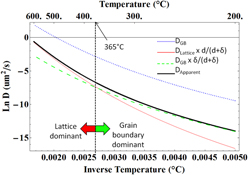Crossref Citations
This article has been cited by the following publications. This list is generated based on data provided by
Crossref.
Cai, Z.P.
Ai, B.Q.
Cao, R.
Lin, Q.
and
Chen, J.H.
2016.
Microstructure and properties of aluminum AA6061-T6 to copper (Cu)-T2 joints by cold metal transfer joining technology.
Journal of Materials Research,
Vol. 31,
Issue. 18,
p.
2876.
Vecchio, Kenneth S.
and
Jiang, Fengchun
2016.
Fracture toughness of Ceramic-Fiber-Reinforced Metallic-Intermetallic-Laminate (CFR-MIL) composites.
Materials Science and Engineering: A,
Vol. 649,
Issue. ,
p.
407.
Huang, Zhequn
Date, Kenji
Tatsugawa, Kiyoshi
and
Ando, Teiichi
2018.
Characterization of Al Skeletal Structures Fabricated by Ultrasonic Powder Consolidation.
Metallurgical and Materials Transactions A,
Vol. 49,
Issue. 12,
p.
6173.
Deshpande, Anagh
and
Hsu, Keng
2018.
Acoustic energy enabled dynamic recovery in aluminium and its effects on stress evolution and post-deformation microstructure.
Materials Science and Engineering: A,
Vol. 711,
Issue. ,
p.
62.
Deshpande, Anagh
and
Hsu, Keng
2018.
Acoustoplastic metal direct-write: Towards solid aluminum 3D printing in ambient conditions.
Additive Manufacturing,
Vol. 19,
Issue. ,
p.
73.
Deshpande, Anagh
Tofangchi, Alireza
and
Hsu, Keng
2019.
Microstructure evolution of Al6061 and copper during ultrasonic energy assisted compression.
Materials Characterization,
Vol. 153,
Issue. ,
p.
240.
Hehr, Adam
and
Norfolk, Mark
2019.
A comprehensive review of ultrasonic additive manufacturing.
Rapid Prototyping Journal,
Vol. 26,
Issue. 3,
p.
445.
Hehr, Adam
Norfolk, Mark
Sheridan, John
Davis, Matthew
Leser, William
Leser, Patrick
and
Newman, John A.
2019.
Spatial Strain Sensing Using Embedded Fiber Optics.
JOM,
Vol. 71,
Issue. 4,
p.
1528.
Moisy, F.
Sauvage, X.
and
Hug, E.
2020.
Investigation of the early stage of reactive interdiffusion in the Cu-Al system by in-situ transmission electron microscopy.
Materialia,
Vol. 9,
Issue. ,
p.
100633.
Ward, Austin A.
and
Cordero, Zachary C.
2020.
Junction growth and interdiffusion during ultrasonic additive manufacturing of multi-material laminates.
Scripta Materialia,
Vol. 177,
Issue. ,
p.
101.
Pagan, Michael
Petrie, Christian
Leonard, Donovan
Sridharan, Niyanth
Zinkle, Steven
and
Babu, Sudarsanam Suresh
2021.
Interdiffusion of Elements During Ultrasonic Additive Manufacturing.
Metallurgical and Materials Transactions A,
Vol. 52,
Issue. 3,
p.
1142.
Hehr, Adam
Norfolk, Mark
Wenning, Justin
Sheridan, John
Ahlfors, Magnus
Mastropietro, A. J.
Maghsoudi, Elham
and
Roberts, Scott N.
2021.
Hot Isostatic Pressing of Ultrasonic Additive Manufacturing Liquid Cold Plate Heat Exchangers.
Journal of Spacecraft and Rockets,
Vol. 58,
Issue. 3,
p.
910.
Monaghan, T.
Harding, M. J.
Christie, S. D. R.
Harris, R. A.
and
Friel, R. J.
2022.
Complementary catalysis and analysis within solid state additively manufactured metal micro flow reactors.
Scientific Reports,
Vol. 12,
Issue. 1,
Massey, Caleb P.
Gussev, Maxim N.
Havrilak, Cody J.
Seibert, Rachel L.
Cakmak, Ercan
and
Nelson, Andrew T.
2022.
On the efficacy of post-build thermomechanical treatments to improve properties of Zirconium fabricated using ultrasonic additive manufacturing.
Additive Manufacturing,
Vol. 59,
Issue. ,
p.
103110.
Zhou, Yanyuan
Chen, Jinyong
Wang, Zhenqiang
and
Jiang, Fengchun
2022.
Interfacial texture and bonding strength of Cu/Al laminate metal composite fabricated by ultrasonic additive manufacturing.
Science and Technology of Welding and Joining,
Vol. 27,
Issue. 7,
p.
501.
Friel, Ross J.
2022.
Encyclopedia of Materials: Metals and Alloys.
p.
134.
Pagan, Michael
Ohmura, Takahito
Wang, Ling
Zinkle, Steven
and
Babu, S. S.
2022.
Strengthening Effects at Dissimilar Metal Interfaces Created by Ultrasonic Additive Manufacturing.
Metallurgical and Materials Transactions A,
Vol. 53,
Issue. 10,
p.
3547.
Zhou, Yanyuan
Wang, Zhenqiang
Sun, Bin
Chong, Yan
and
Jiang, F. C.
2022.
Formation of Face-Centered Cubic Titanium During Ultrasonic Consolidation of Commercially Pure Titanium/Aluminium Dissimilar Metals.
SSRN Electronic Journal ,
Ward, Austin A.
Leonard, Donovan N.
König, Hans-Henrik
Lindwall, Greta
and
Cordero, Zachary C.
2022.
Ultrasonic additive manufacturing of nanocrystalline laminated composites.
Journal of Materials Research,
Vol. 37,
Issue. 1,
p.
247.
Massey, Caleb P.
Bibhanshu, Nitish
Gussev, Maxim N.
Havrilak, Cody J.
and
Nelson, Andrew T.
2022.
Deformation and fracture characteristics of zirconium plate produced via ultrasonic additive manufacturing.
Journal of Materials Research,
Vol. 37,
Issue. 1,
p.
236.



